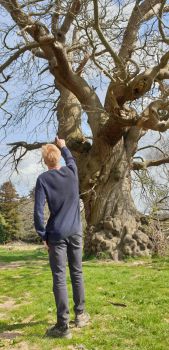New research published by the University of Sussex suggests that wild honey bee colonies are in abundance in the UK, thanks to our ancient or veteran trees.
In a new paper, researchers estimate that around 40,000 wild-living honey bee colonies could be nesting in ancient or veteran trees in England, with around 75,000 across the UK. But with UK trees under threat from the likes of disease, development and severe climate related weather, this latest research shows the value of veteran trees to our most important pollinators.
Weird, the article doesn’t load for me on desktop, I just get the title. Here’s the full text in case anyone else has the same issue:
New research published by the University of Sussex suggests that wild honey bee colonies are in abundance in the UK, thanks to our ancient or veteran trees.
In a new paper, researchers estimate that around 40,000 wild-living honey bee colonies could be nesting in ancient or veteran trees in England, with around 75,000 across the UK. But with UK trees under threat from the likes of disease, development and severe climate related weather, this latest research shows the value of veteran trees to our most important pollinators.
Ancient trees are old, with very wide and hollowing trunks in comparison to other trees of the same species. Veteran trees may not be old, but have developed some of the characteristics found on ancient trees, such as cavities, making both trees great homes for wildlife.
Professor of Apiculture at the University of Sussex, Francis Ratnieks, and PhD student Oliver Visick used the Woodland Trust Ancient Tree Inventory (ATI), which maps ‘the oldest and most important trees in the UK’ to better understand the number of veteran trees that were being used as nest sites for native honey bees. They surveyed 1,052 ancient and veteran trees across East Sussex, West Sussex, Kent, Surrey and Greater London and found 22 honey bee colonies, meaning 2% of the trees surveyed in the area were occupied by nesting colonies.
Using this data, the researchers have been able to develop estimates that cover England and the UK, confirming that ancient and veteran trees are incredibly important for wildlife, with honey bees nesting in the hollows of a variety of different tree species. Cavities large enough for honey bee colonies take a long time to develop, which is why protecting our trees as they grow is so crucial for the future of native honey bees, an incredibly important crop pollinator.
University of Sussex’s Professor Francis Ratnieks explains:
“Veteran trees by their very nature take centuries to develop. It has long been known that these trees can be important for wildlife, providing special habitats that are rare or not found in younger trees. Although honey bees are often thought of as domesticated, they are not. As our research indicates, there are tens of thousands of honey bee colonies living in ancient and veteran trees in Britain. They are of huge value to a number of species and need to be properly protected and conserved.”
PhD student and lead researcher, Oliver Visick says:
“Our results show that veteran trees provide a valuable nesting habitat for an important native pollinator, the honey bee. Tree databases, such as the Ancient Tree Inventory, can be a useful tool for identifying areas where wild honey bee colonies, and other cavity-nesting species, might be present.”
The Sussex researchers have also looked further afield and discovered that worldwide there are two to three times as many wild honey bee colonies as there are in managed hives. Wild honey bees are not currently endangered, but threats to trees both in the UK and across the globe would have a significant impact on honey bee colonies.



